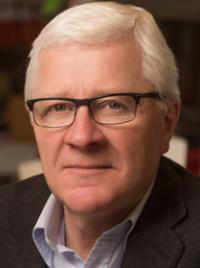


John E Dick, PhD, FRS
- Summary of Previous Research
The development of xenograft assays. Dr. Dick developed the first system, modeled after clinical transplantation, for transplanting human hematopoietic cells into immune-deficient mice with resultant multilineage repopulation of murine hematopoietic tissues. He also developed the first xenograft models of human leukemia (B-ALL, AML, CML). This xenograft assay is accepted worldwide as the “gold standard” for detecting human HSC and LSC and is used to evaluate many therapeutics leading to more effective clinical trials.
The elucidation of the roadmap of human hematopoiesis and isolation of human HSC. Dr. Dick has provided insight into the composition and heterogeneity of the human HSC pool. His team has uncovered a novel sorting approach that was combined with single cell functional assays and culminated in the first isolation of near-pure populations of ten human HSC and progenitor fractions. Transcriptional profiling of these populations has yielded the first comprehensive analysis of the molecular regulation of early fate determination in human hematopoiesis. The isolation a single HSC capable of regenerating the entire blood system represents an achievement that will advance our understanding of human HSC biology, as well as enable substantial improvement in the clinical application of HSC-based therapiesThe unification of CSC and genetic diversity models of tumor heterogeneity. The CSC and genetic evolution models describing tumor cell heterogeneity have often been viewed as mutually exclusive. Dr. Dick challenged this view and showed that leukemia-initiating cells (L-IC) are genetically diverse and evolve through complex evolutionary lineage relationships. This sets the stage for a unified view of cancer that accommodates both heterogeneity models.
- Current Research Projects and Goals
The long-term goal of our research program is to elucidate the mechanisms underpinning the stemness state of human hematopoietic stem cells (HSCs) and leukemia stem cells (LSCs) and to transform these findings into new therapies and biomarkers. Simply put, guided by these fundamental research questions:
- What makes a stem cell a stem cell?
- Which stem cell properties are shared between HSCs and LSCs?
- Which are different?
- How do HSCs transform into LSCs?
Specifically, we are:
1) Aiming to refine our new AML classification framework and advance it into clinical testing. By deploying the new hierarchy classification biomarkers on remission cells recovered from patients who are poised to eventually relapse, our research will unlock a new opportunity to consider clinical trials to prevent relapse through earlier targeting of relapse-fated LSC. (Funded by Canadian Institutes for Cancer Research, Canadian Cancer Society – Research Institute, and Ontario Institute for Cancer Research)2) Advancing the mechanistic understanding of human leukemic processes and providing rich avenues of clinical translation, including development of candidates for therapeutic targeting and novel biomarkers of relapse-fated subclones that permit monitoring of patients at risk for relapse. Our ultimate goal is targeting minor relapse-fated subclones while they remain vulnerable, before they engender further mutational progression resulting in therapy resistant relapse disease. (Funded by Canadian Institutes for Cancer Research, Canadian Cancer Society – Research Institute and Terry Fox Research Institute)
3) Focusing on age-related clonal hematopoiesis and cardiovascular disease by a) defining the specific genetic features that distinguish individuals with ARCH that are linked to increased risk of CVD with those of individuals with ARCH but who do not progress to CVD; b) investigating blood samples banked from individuals identified with ARCH-CVD risk and undertake single cell transcriptional and epigenetic analysis of defined HSC, progenitors and mature lineage cells to determine the mechanism of how the specific features of ARCH-CVD perturb normal blood development to contribute to eventual CVD disease. (Funded by Medicine by Design, University of Toronto, Canada First Research Excellence Fund, Cycle 2 Award)
Related Links
Professor, Department of Molecular Genetics, University of Toronto
Director, Program in Cancer Stem Cells, Ontario Institute for Cancer Research (OICR)
Canada Research Chair in Stem Cell Biology




 https://orcid.org/0000-0002-9527-8317
https://orcid.org/0000-0002-9527-8317